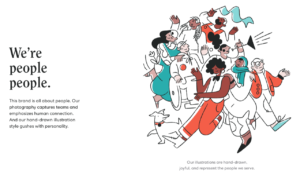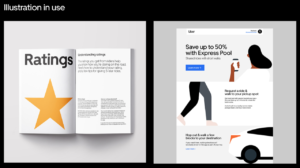How to Use the Mosaic Principles to Improve Diversity & Inclusion Practices at Your Agency
Author: Arthur Goodman
Lately it seems like almost every week there is a company going through a brand identity update. From flatter logos, to the inclusion of simple-shaped symbols, or even gradient color schemes - so many organizations are looking to better connect with the growing customer base.
I love brand identity updates, but one of the most intriguing elements I see recurring throughout these new visual identities is the use of illustrations, and specifically the use of designs that demonstrate a diverse audience.
For example, let’s check out one of my favorite brand updates of 2019 - Gusto. This platform is all about serving people, so it makes sense to ensure that the people represented by the brand are as diverse as their customer base. Within their illustrations you can identify people with various skin tones, clothing styles, interests, and even different physical abilities.
Not only does this rebrand make Gusto’s customers feel welcome and represented, but it also further aligns Gusto as an organization with their core values of being in service to all people, which is a testament to their focus on diversity and inclusion initiatives.
What’s the Difference Between Diversity & Inclusion?
It’s quite common for people to think of the terms diversity and inclusion as synonyms, but there is actually a distinct difference between the two concepts.
Joni Davis, Vice President and Chief Diversity Officer for Duke Energy, sums up the differences by using a great sports analogy, “Diversity speaks to who is on the team, but inclusion focuses on who is really in the game.”
I think this is such a great way to visualize why both concepts are so important to implement with any organization. Yes, it’s very important to incorporate many different types of people to be a part of your team, but if they aren’t playing an active role to represent their different perspectives, than your team really isn’t experiencing the full benefit of diversity.
Incorporating diversity and inclusion practices within your organization is also just a smart business decision. According to an Accenture research study, “nearly two-thirds (63%) of surveyed global consumers prefer to purchase products and services from companies that stand for a purpose that reflects their own values and beliefs, and will avoid companies that don’t.”
Source: LinkedIn
A Quick Introduction to AAF’s Mosaic Council
The American Advertising Federation’s (AAF) Mosaic Council is the advertising industry’s leading think tank on diversity and inclusion. To create a foundation of their expertise, the members have created what’s known as the Mosaic Principles which offers agencies and companies at-large with standards and recommendations to institute good practices.
The council has established 4 principles, so let’s take moment to review them quickly!
The Four Mosaic Principles
1. We must recruit for America.
Not to make things “political,” but this first principal can be a bit jarring at first glance (at least to me). However, the deeper message from the Mosaic Council is something that I think anyone who is a supporter of diversity and inclusivity practices can rally behind.
“We believe that the future of the industry is reliant on a workforce that reflects the diversity of demographics, lifestyle, experience and mindset of America today and tomorrow. For long-term success, the advertising industry must better represent the mixtures that make America great.”
Again, an interesting choice of words (especially the last 3 words), but overall, this principle is about representing every aspect of the melting pot that is the USA throughout the advertising industry.
2. We must recognize the diversity of talent within the industry.
With this second principle, the council goes on to explain that “Recognition comes with reward. We must bring greater awareness to the hidden storytellers, innovators and provocateurs in the industry.”
There are so many different types of people who play important and vital roles, but many times they are not recognized outside of the walls of their organization. Providing greater exposure to the individuals who are typically not placed under the spotlight is an important initiative for every organization to focus on.
Source: Uber
3. We must provide greater access to development and leadership opportunities.
To be a member of AAF means that you are interested in the growth and development of the advertising industry as a whole. That includes not only the campaigns produced, but also the people within the agencies that produce such amazing work for their clients.
I see this third principle as such a great and helpful challenge to agency leaders to provide more leadership and learning opportunities for their entire team. When given the chance to manage a team or take the lead on a project, individuals are given experiences that end in both success and failure - both of which are tremendously important events to foster growth and development.
For those of you who are a part of leadership teams, I challenge you to identify the untapped talent at your organizations and give them a trial run in the point position of a team or an upcoming project. I guarantee that both you and the individual will experience a great deal of learning, and may even experience a few unexpected surprises to improve your agency!
For those of you at organizations waiting to be given a chance to shine, I challenge you to stop waiting and to speak with a leader about taking on greater responsibility. At least make sure that your leadership is aware of your desire to grow within the team.
4. We must encourage the industry to portray realistic images of multicultural youth and communities.
This final principle is so important, and perhaps can be the easiest principle to begin implementing at your organization.
The Mosaic Council further explains, “Presenting realistic images of multicultural markets can play a key role in creating a society that is inclusive of the many consumers who define the American marketplace and dispel the stereotypes that have been perpetuated for far too long.”
The visual component of storytelling is so crucial to messaging, so each storyteller (AKA your agency or organization) must make conscience efforts to represent and respect the audiences being addressed. Be intentional with your choices about the characters within the story you are conveying.
Some Final Words
So there they are! The definitive diversity and inclusion principles established by the Mosaic Council to be used by advertising agencies throughout the USA. As we look to further develop the advertising industry, I hope these principles will become a part of your organization’s standard practices.
To learn more about diversity & inclusion practices, or to gain assistance with implementing these principles at your workplace, please contact me at arthur@agmgconsulting.com.
Interested in getting involved with supporting these principles throughout Orlando? Join the AAF Orlando Diversity & Inclusion Committee by visiting https://www.aaf-orlando.org/get-involved/.
About the Author: Arthur Goodman is a business consultant and HubSpot Partner who helps business owners and entrepreneurs optimize their business strategies and improve sales performance. He is the founder of AGMG Consulting, a co-owner of RedFork Marketing, and currently serves as the Diversity & Inclusion Committee Chair of AAF Orlando.
www.arthurgmgoodman.com | www.linkedin.com/in/arthurgmgoodman/
Additional Resources:



